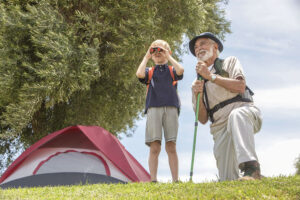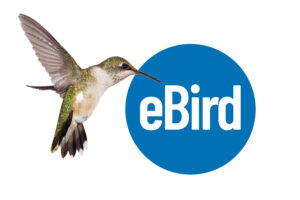 Chances are someone you know is a birdwatcher. According to U.S. Fish and Wildlife Service, of all wildlife in the U.S., birds attract the largest following. It estimates 45.1 million people in the nation are birdwatchers and rack up a whopping average of 96 days annually of bird observing.
Chances are someone you know is a birdwatcher. According to U.S. Fish and Wildlife Service, of all wildlife in the U.S., birds attract the largest following. It estimates 45.1 million people in the nation are birdwatchers and rack up a whopping average of 96 days annually of bird observing.
“Birdwatching isn’t just a group of goofy-looking people running around with binoculars,” says Jim Herkert, executive director of the Illinois Audubon Society. “There’s lots of normal, everyday people who are birdwatchers: lawyers, doctors, a whole range of folks.” He says there’s even a trend of punk rockers getting into it.
More than 420 species of birds have been spotted in Illinois. Fish is the only group with more species. “Of course, the big difference is that you can see virtually all birds,” Herkert says. “The fact that they are all around us and there’s such a wide diversity of them I think is one of the reasons people love them.”
According to Herkert, Illinois is one of the best spots in the country for birdwatching, and that’s because Illinois is in a flyway. The main one in the U.S. is the Mississippi Flyway where birds tend to follow the Mississippi River and Illinois River during migration.
While there are birds that nest in Illinois year-round, every spring and fall there are huge numbers of birds that go from the tropics to Canada. They go north to breed and come back in the fall.
Early bird catches the worm
 It’s never too late or too early to start birdwatching. While some kids get into it at a young age, others start later because the opportunity aligns. Herkert admits that he was a little birder as a kid.
It’s never too late or too early to start birdwatching. While some kids get into it at a young age, others start later because the opportunity aligns. Herkert admits that he was a little birder as a kid.
“We traveled a lot as a family,” Herkert explains. “I would try to identify birds we saw around the campsite.” But he got hooked on it in college.
“I’m sort of bird crazy,” he says. “To me, birdwatching is sort of a puzzle. Can I solve this puzzle? I just have fun with it. There’s no pressure. It is just like detective work.”
He says to start by trying to identify the birds you see, whether it’s around the house or when you are traveling. However, there is much more to birdwatching than identifying bird species.
“Birdwatching is fun. It’s relaxing. It’s destressing,” Herkert says. “Spending time outdoors is good for your health. It could be what motivates people to get outside. It could be time to spend with your kids… It helps connect you with the natural world around you.”
“There are people who are absolute avid birders to the point where they’re always birding,” says Jo Fessett, assistant to the executive director of the Illinois Audubon Society. “Some go out of the state or out of the country. Then there’s a good flock of them that just want to sit and watch their backyard.”
Get your ducks in a row
When it comes to birdwatching, not many supplies are needed. First, start off with a decent pair of binoculars. “You could buy a pair for $50, or you could spend $3,000 on a pair,” Herkert explains. “If you are starting out, I would not recommend the cheapest pair. For $50 to $100, you can get a decent pair that would certainly get you started.”
I n addition, a notebook will help keep track of the birds you see. “Birders are compulsive listers,” Herkert says. Most birdwatchers keep several lists. “Some will have a yard list, a county list, a list of birds seen this year and a lifetime list.”
n addition, a notebook will help keep track of the birds you see. “Birders are compulsive listers,” Herkert says. Most birdwatchers keep several lists. “Some will have a yard list, a county list, a list of birds seen this year and a lifetime list.”
For beginners, it may be difficult to tell the difference between species. That’s where a good field guide comes in. “Field guides are great,” says Kaleb Baker, land steward for the Illinois Audubon Society. “They have information on how to tell the difference between similar looking species.”
Baker helps manage the 3,000 acres across the state that the society owns. While he’s more focused on the habitat that’s home to birds and other wildlife, he considers himself a budding birder. “I’m still very much learning to bird, which is fun,” he says. He also suggests tools for birdwatching that can’t be purchased. “You need a lot of patience and persistence.”
Rule the roost
 Birdwatching is growing in popularity and is a hobby practically anyone can do. “Birdwatching is great for people of all ages,” Fessett says. “You don’t have to be outside. You can just sit in your window and watch.”
Birdwatching is growing in popularity and is a hobby practically anyone can do. “Birdwatching is great for people of all ages,” Fessett says. “You don’t have to be outside. You can just sit in your window and watch.”
According to Herkert, most birdwatchers primarily bird in their yard. “I count in my backyard every morning, and I frequently count 20 to 25 different kinds of birds in five minutes,” he says.
For beginners, the Illinois Audubon Society suggests starting by trying to identify birds in your yard. To attract more birds, have a water source and a variety of feeders to bring in different species. You can even plant different kinds of shrubs and trees.
“The more diverse your yard and what you feed, the more diverse the birds,” Herkert explains.
Fly the coop
There are many who travel to look for birds. That could be anywhere from a city park, state park or county forest preserve. “Any public land tends to be where people go,” Herkert says. “By visiting different kinds of habitats, the more bird species you’re going to see.”
If you’re getting started, Herkert advises to look for a bird hike in your area where you can go out with people who have birding experience and help you find birds.
“I would recommend reaching out and try to find a local Audubon group,” Herkert suggests. “Just look for bird hikes in your area. There could be a nature center that hosts a bird hike.”
Birdwatching is also a great way to socialize. “People go out and bird together,” Herkert explains. “There’s lots of ways it could get into your social fabric.”
If you’re looking to travel somewhere to bird, most of the Illinois Audubon Society’s sanctuaries are public accessible including some with trails and facilities. Visit illinoisaudubon.org to learn more.
Take someone under your wing
 “Take a kid birding.” That’s Fessett’s advice for the experienced birdwatcher. She knows this from experience because she’s been birding since she was around 9 and remembers the first pair of binoculars she received for her birthday. “My dad knew his birds really well, so it was a challenge for me to spot the bird and know what it was before him.”
“Take a kid birding.” That’s Fessett’s advice for the experienced birdwatcher. She knows this from experience because she’s been birding since she was around 9 and remembers the first pair of binoculars she received for her birthday. “My dad knew his birds really well, so it was a challenge for me to spot the bird and know what it was before him.”
“Share your passion with someone else and encourage them,” Herkert agrees. “Get them hooked by sparking their curiosity. You really need someone who has a little bit of experience to provide a better spark.”
Ways you can help get others involved in birdwatching is by giving a birdwatching starter pack (complete with binoculars, a field guide and a notebook), organize a group outing, and be there for advice and tips.
“I have people call me and say, if I sing the tune, can you tell me what it is? They send us photos, soundbites and even funny stories,” Fessett says. “We like to find the spark that gets people interested. If they get interested in birds, at some point they will realize they need to protect the habitat. Once they love the creature, they want to protect its habitat.”
eBird
A helpful tool for new and experienced birders is eBird, and it comes highly recommended by the Illinois Audubon Society. It’s a website and an app that can be downloaded to a smartphone.
 “If you’re not into eBird, you should be,” says Jim Herkert, executive director of the Illinois Audubon Society. “Beside it being fun, you can put your data in, and it actually helps conservation. Second, it’s great because it is global. You can use it as a resource anywhere.”
“If you’re not into eBird, you should be,” says Jim Herkert, executive director of the Illinois Audubon Society. “Beside it being fun, you can put your data in, and it actually helps conservation. Second, it’s great because it is global. You can use it as a resource anywhere.”
All you must do is create an eBird account, and you can start keeping track of your bird lists, upload photos and sound bites you capture, and report observations.
There’s also an interactive map that shows the location of bird sightings, types of birds found there and time the birds were seen. If you’re looking for a specific bird, you can search for it and find locations where others have spotted that bird.
“It’s kind of like a Google map,” says Jo Fessett, assistant to the executive director of the Illinois Audubon Society. “It’s also helpful if you’re a new birdwatcher and not sure what you’ve just seen. Go see what other people are reporting and it might give you some help in narrowing down.”
The map on the eBird site is color coded. As you zoom in, you can see places where people have seen a lot of birds. It is a resource that can help find the best places to bird.
“I would encourage any parent or grandparent with a young child to have that child start an eBird account. It’s free,” Fessett says. “It will follow you your entire life. In years to come, you can look back at it.”
While this tool is helpful for birdwatchers, eBird is also used to help conservation. “Birds are such an environmental indicator,” Fessett explains. “If there’s a trend, it’s an indication that something is going on in that ecosystem.”
“Because of migration, [eBird] has the potential to build a connection that’s way beyond Illinois,” Herkert says. “It helps build connections to other parts of the world.”
Illinois Audubon Society
The Illinois Audubon Society is Illinois’ oldest conservation organization. It was founded in 1897 and had a mission to protect birds and advocate for wildlife. Some of the earliest work the society did was to help establish federal laws for bird protection, promote conservation, establish state parks and county forest preserve districts, and stop pollution.
“Birds are still a major focus for us,” says Jim Herkert, executive director of the Illinois Audubon Society. “But now the mission is to promote the appreciation and perpetuation of the flora and fauna of this state and the habitats that they need. It is a broader mission, but birds are still the key focus for us and many of our members.”
The organization owns more than 3,000 acres of wildlife sanctuaries across Illinois. Most of these sanctuaries are publicly accessible and open from dawn to dusk. Additionally, there are 17 chapters of the Illinois Audubon Society scattered across the state that offer many programs that include birdwatching field trips, conservation projects and educational programs.
For more information about the Illinois Audubon Society, to locate a local Audubon chapter or become a member, visit illinoisaudubon.org.
Bird photos courtesy of Maurice Shallow.










